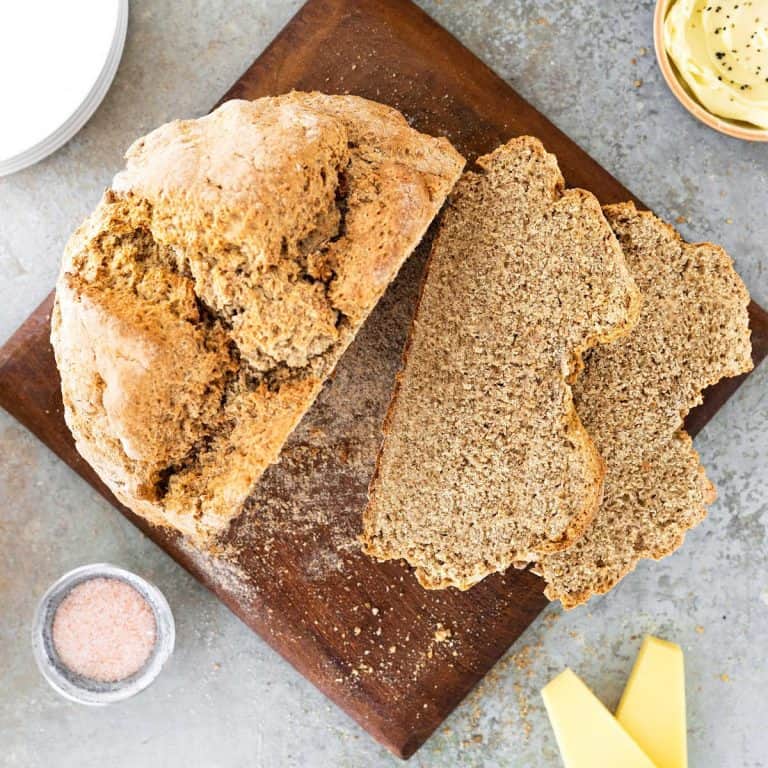Ingredients
- 1 1/2 cups (200g) all-purpose flour
- 2 1/2 cups fine whole wheat flour
- 1 1/2 teaspoons salt
- 1 1/4 teaspoons baking soda
- 2 cups buttermilk (see Notes below for making it at home)
- 2 tablespoons unsalted butter, melted
Instructions
- Preheat the oven to 425°F/220°C.
- Have ready a baking sheet dusted with flour.
- Stir together both flours in a large bowl.
- Sift baking soda and salt over them and combine.
- Add the buttermilk and melted butter and mix with a wooden spoon until it's all moistened. This is quick, several strokes and that's it. We don't want to overwork the dough.
- Dump this shaggy mass onto a lightly floured counter or surface.
- Sprinkle the top lightly with whole wheat flour and bring it all together, folding it quickly onto itself, and forming it into a loose ball. It might be more or less firm depending on your whole wheat flour, but you don't need to knead it. If you add too much flour it will be tougher after it's baked, especially the crust. So don't be tempted to make it into a smooth ball, it's meant to be rustic.
- Place it in the prepared pan (I find it easier with the help of a spatula or dough scraper).
- Slash the top with a kitchen knife, making a cross pattern, cutting it about 1/2 to 3/4 inch deep (no more), and immediately put the pan in the oven. Baking soda starts acting when you add liquid, so you want to start baking the bread as soon as possible.
- Bake for 10 minutes and turn the oven temperature down to 375°F/190°C.
- Continue baking for about 35 more minutes, until it's golden and firm to the touch. A cake tester or toothpick should come out clean. You can open it slightly, carefully lifting the top with a fork, and make sure it's completely baked inside because it turns golden after 20-30 minutes but, usually, the crumb inside is still raw, so make sure. You can cover the top with a piece of aluminum paper if it's browning too quickly but you need to bake it longer. Also, turn the bread over and tap with your knuckles, it should make a hollow sound when fully baked.
- Let cool on a wire rack for 15 minutes before slicing.
- Eat warm or at room temperature. It's best eaten the same day it's baked.
Notes
Homemade buttermilk: put 2 tablespoons of white vinegar or lemon juice in a measuring cup and add milk until you reach the 2-cup mark. Let it stand a minute or two until it curdles and thickens, then use it in the recipe.
Baking time: remember that all ovens and pans are different, even if they look similar. The baking time in my recipes is as accurate as it can be, but it might take you more or less time. You can use a thermometer(like the OXO oven thermometer) to check that your oven is at the right temperature. I recommend you keep track of how your oven works and what tiny details you might need to adjust.
Ingredients: don't substitute them; they are all necessary for the best results.
Sift the baking soda: it tends to harden when stored, and you will probably find clumps when you measure it. Sifting before adding it to the flour will ensure it's well integrated. This is very important, so don't skip it.
Overmixing the dough: Brown soda bread dough should only be mixed until the ingredients are just combined. Overmixing can lead to a tough, dense bread.
Dough too dry or too wet: the texture of the dough is important for the success of your bread. If the dough is too dry, the bread may turn out crumbly and dense. If the dough is too wet, the bread may not rise properly and may have a gummy texture. You should be able to form a round loaf and make the top cut. If in doubt, always err on the side of a wetter than drier.
Oven temperature: this bread needs to be baked at a high temperature (around 200-220°C) in the beginning to create a crusty exterior. If the oven temperature is too low, the bread may not rise properly and may be undercooked.
Eat it the day it's baked, preferably within the first hours. I strongly recommend this. This no-yeast bread hardens quickly. If you want to freeze it, do so while still barely warm and wrap it well in plastic and then foil. I also recommend slicing it first to have individual toast whenever you want.
- Prep Time: 10 minutes
- Cook Time: 45 minutes
- Category: Bread
- Method: Baking
Nutrition
- Serving Size: 1/12
- Calories: 177
- Sugar: 2.1 g
- Sodium: 465.5 mg
- Fat: 1.8 g
- Carbohydrates: 33.8 g
- Fiber: 1.1 g
- Protein: 5.6 g
- Cholesterol: 4.5 mg
